2016 Winners!
We’re excited to announce the winners of the first-annual Robot Art competition!
As this is a 5-year competition, the expectations of this first year were modest – get as many teams as possible to setup a robot that can do any sort of painting. I believe that we succeeded. In total, there were 16 teams from 7 countries who submitted over 70 different artworks!
Winners were determined based on a combination of public voting (over 2200 people with a Facebook account voted), 5 judges consisting of working artists, critics, and technologists, and by how well the team met the spirit of the competition – that is, to create something beautiful using a physical brush and robotics and to share what they learned with others. Learn more about the goals of the contest and its rules here.
Originally, there was to be two categories of artwork based on how much physical involvement the human had during the painting process. Since it was ultimately difficult to incorporate these categories in the voting and judging process, we decided to combine the categories and adjust the prize money slightly according to the artworks original category. We also decided to award prizes based on teams instead of individual artwork but feel that all of the paintings on this page are exceptional.
Read more about robot art (useful for journalists/press).
… and now, for the team winners of the 2016 Robot Art Competition…
1st Place – $30,000 – TAIDA, National Taiwan University
TAIDA won as they got the most public votes, did well by the judges, and fulfilled the spirit of the contest by using a physical brush to paint something beautiful… as well as shared the details of how their system works. Some comments by the judges:
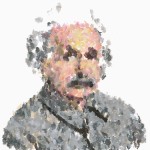
Albert Einstein
“I am impressed that the robot used such a limited palette, mixing on the canvas with the brush to broaden the color options. The portrait is suggested without being overly detailed, yet remains clear as to who it is portraying.” – Anne Petty
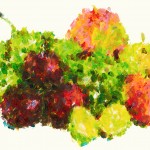
Still Life
“With TAIDA’s “Still Life,” we were particularly struck by the relative sophistication in the robot’s color mixing. This piece required a wide range of tones within a single color scheme in order to accurately reproduce the three-dimensional depth of the original piece, and the robot seemed to handle this quite successfully, producing an image that was probably the most “3D” of any of the autonomous works.” – Patrick/Jeannie Wilshire
2nd Place – $18,000 – CloudPainter, George Washington University
CloudPainter’s works were judged highly by the judges and public as well as used a brush creatively. Some comments:
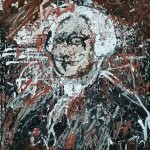
Crowdsourced Washington
“Use of tone and expression brought to mind the work of Jean Dubuffet, with an example such as ‘Paysage’ from 1944.” – Matthew Carver
“I am especially drawn towards the expressiveness of this particular work, and love that it’s a collaborative piece. The painting feels unique in style and very painterly–not digital or robotic.” – Anne Petty
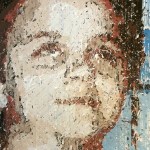
Hunter
“Although cloudPainter did work from photo reference, the designers allowed the robot to handle the additional step of analyzing a series of reference photos and making its own decision regarding WHICH photo was the most artistically pleasing and producing its own crop of the image, which put the robot one step further into the art creation process than our 3rd through 5th place votes. The use of the visual feedback loop to determine where and how much to paint is very analogous to the human process of painting. Again, the final piece is artistically successful as well.” – Patrick/Jeannie Wilshire
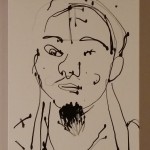
Kid Sourced Portrait
“There is an elegant use of line within this work, bringing to mind Japanese ink paintings. Well, maybe that’s reaching… but, it would be interesting to see how work like this may progress.” – Matthew Carver
3rd Place – $12,000 – NoRAA, Accademia di Belle Arti di Brera
NoRAA was the judges favorite although they used a more traditional plotter for execution.
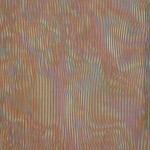
80x60cm
“Extremely interesting and innovative work using robotics… I would definitely add one of these works to my personal collection!” – Sarah Nind
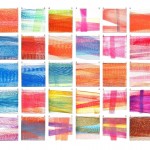
200x400cm
“Another favorite” – Sarah Nind

210×240
“I found this collection of paintings to be conceptually strong and unique, with the layers producing a satisfying spatial quality. ” – Anne Petty

35x35cm
“Of all the pieces wesaw, we thought this one was the most successful artwork produced BY a robot, rather than THROUGH a robot. The fact that the AI develops the image design itself, rather than working from a reference photo or photos, was significant, and the final artwork is a successful abstract, with a simple overall pattern but a more complex structure within. The fact that Patrick was also able to produce work in larger sizes and on canvas was also a plus.” – Patrick/Jeannie Wilshire
4th Place – $10,000 – e-David, University of Konstanz
e-David submited a single, beautiful painting for the contest to the delight of the judges.
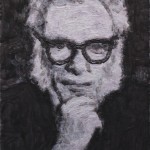
Isaac Asimov
“Although eDavid worked from a single image, chosen by the designers, its process and result were perhaps more painterly, in the end, then either of the previous two. So we gave more points for artistic success (plus an extra bonus because Isaac Asimov is awesome) and then factored in the image selection system as well as the feedback system (again, visual).” – Patrick/Jeannie Wilshire
“This painting was built in a manner that is similar to how many painters work: first establishing the overall structure through general larger shapes, then moving onto smaller more complex areas. As a result, the surface of the painting is active and nicely built up and the process makes sense to me as a painter.” – Anne Petty
“Although PhD student, Thomas Lindemeier states he isn’t interested in a photorealist language, his 12,000 automated brush strokes added together still result in a painted image bound in the language of photography. Unlike a contemporary art pillars like Gerhard Richter who renders his photobased paintings with pulls and swipes, or Luc Tuymans, who renders ranges of blurriness and focus through careful wet in wet gestures, here it appears to be the result of both formulated algorithms and robot manual distribution of paint. It raises an interesting dialogue between paintings generated by human optimisation dependent on intuition and studio skill, and those resulting from an optimisation grounded in machine processes controlled through algorithms, machine learning and possible computational creativity.” – Matthew Carver
5th Place – $8,000 – RHIT Rose-Hulman Institute of Technology
RHIT took a fairly traditional, yet effective, approach to using a robot to paint and was popular among the online voters.
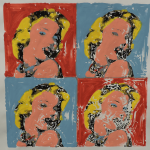
Warholized Marilyn Monroe
“Another favorite” – Anne Petty
6th Place – $5,000 – Picassnake, University of Manitoba
You would never had guessed these paintings were painted by a green snake listening to music.
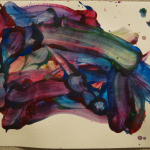
How Far by Greek Riots
“Provocative and ephemeral images, that play with the digital/robotic intervention into abstract expressionism. “- Sarah Nind

Sleep by Greek Riots
“We had a difficult time choosing exactly which of the Picassnake images to select, but we felt that the novelty of their system deserved recognition, even if it ended up being more like robotic interpretive dance with a paintbrush than a true analog to human painting. In the end, we felt that “Sleep by Greek Riots” just had more variety of stroke and direction than the other pieces.” – Patrick Wilshire
7th Place – $4,000 – EyePaint, Imperial College London
This team created an eye tracking system to allow anyone to paint using just their eye movement.

House
Its ability to do more than merely robot paint and instead be a catalyst for human-robot relations and assist impaired humans is excellent and worth rewarding. – Pablo Garcia
8th Place $3,000 – Simple but Significant, Benha Faculty of Engineering (Egypt)
While not winning any awards for the beauty of their artwork, this team did a phenomenal job at getting half of Egypt to support their team by voting online!
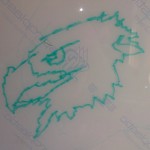
Eagle
9th Place (tie) $2,500 – Guild of Robotic Artisans, University of Minnesota
This team succeeded in getting paint on canvas using a robot that would make any do-it-yourself (DIY) enthusiast proud. While there was some problem getting videos linked, you can watch some here. Hey, if you think painting by hand is hard, try painting with this robot!
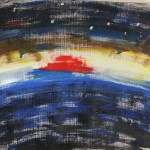
Layers of Sunrise
“Composition and colour choices reminded me somewhat of Copenhagen based artist, Tal R.” – Matthew Carver
9th Place (tie) – $2,500 – A1 – Carnegie Mellon
This team created it’s own unexpected category of robot art – what if the human and the robot held a paint brush at the same time?
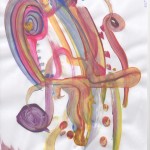
Haptic Art
“Enjoyed the sense of whimsy and freedom from this example of Telerobotic Artwork. ” – Matthew Carver
“Interesting work, trying to speak to a painting aesthetic, but also trying to speak to a child’s aesthetic. I feel this is it’s shortcoming, as only a child can actually create a child’s image.” – Sarah Nind
Honorable Mentions – $1000
UNLV-ERC, UNLV Entertainment Engineering Research Center
artistBots, Independent – Interesting use of a mobile robot.
Pixobot, Université de Picardie Jules Verne
CM2, Ecole du Centre – robot painting by elementary school student class
VIP I-Natural Team 2 , Georgia Institute of Technology
Polar Printing Press, Olin College of Engineering
Special thanks to our judges:
Matthew Carver – Artist – matthewcarver.net
Anne Petty – Artist/Instructor, Gage Academy of Art – annepetty.net
Patrick and Jeannie Wilshire – Directors, IX Arts – imaginativerealism.org
Ken Goldberg – Professor, UC Berkeley – goldberg.berkeley.edu – “A key point to keep in mind is that in every case the robot is a tool, more sophisticated than a brush, but depending fundamentally on the creativity and skill of the humans behind it. “
Pablo Garcia – Assistant Professor, School of the Art Institute of Chicago – pablogarcia.org